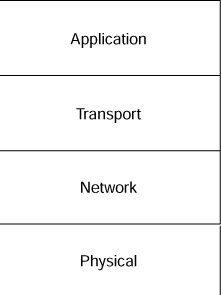Internet Model of Communication
|
| < Day Day Up > |
|
The model of communication for the Internet is a layered model in which each layer provides a distinct function (see Figure 1.2).

Figure 1.2: Layered model for Internet communication.
At the lowest layer is the Physical layer, which is responsible for communication with the physical medium. This traditionally includes not only the physical interface (such as an Ethernet MAC or serial UART), but also the driver software that abstracts the hardware interface to the software.
Moving up the stack, the next layer is the Network layer. The Network layer provides the means to communicate between hosts on a network. The Network layer includes the addressing information that identifies the source and address hosts of the message.
The next layer is the Transport layer. This layer, from a receive standpoint, handles delivery of the message received from the Network layer to the intended application. From a transmit standpoint, the Transport layer multiplexes outgoing messages for delivery to the Network layer. Note that this is a very simplistic description; we delve into more details in the Transport Layer section later in this chapter.
To segment traffic for multiple applications at the Transport layer, some differentiating mechanism is required. Protocols at the Transport layer include a unique port number that uniquely identifies the application from all others. Ports can be dynamically assigned (most common for client applications) or statically assigned (used for server applications). Servers are commonly assigned static ports, also called well-known ports. For example, Web servers are assigned port 80, whereas mail servers typically occupy port 25. Client applications are assigned a port dynamically. These dynamic ports are called ephemeral ports.
The final layer is the Application layer. Applications, from this perspective, are programs that communicate over the network. This includes applications such as a mail client or a Web server. Note that many applications can run on a single host. The port provides the mechanism to demultiplex traffic so that it gets to its intended application on the host.
|
| < Day Day Up > |
|
EAN: 2147483647
Pages: 225
- Chapter II Information Search on the Internet: A Causal Model
- Chapter V Consumer Complaint Behavior in the Online Environment
- Chapter XIII Shopping Agent Web Sites: A Comparative Shopping Environment
- Chapter XIV Product Catalog and Shopping Cart Effective Design
- Chapter XVIII Web Systems Design, Litigation, and Online Consumer Behavior